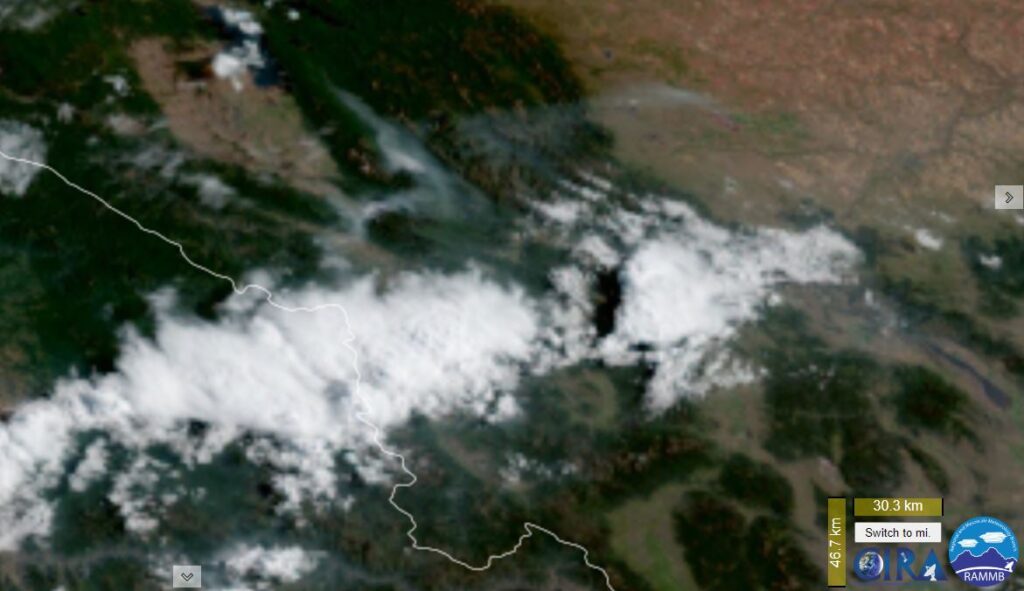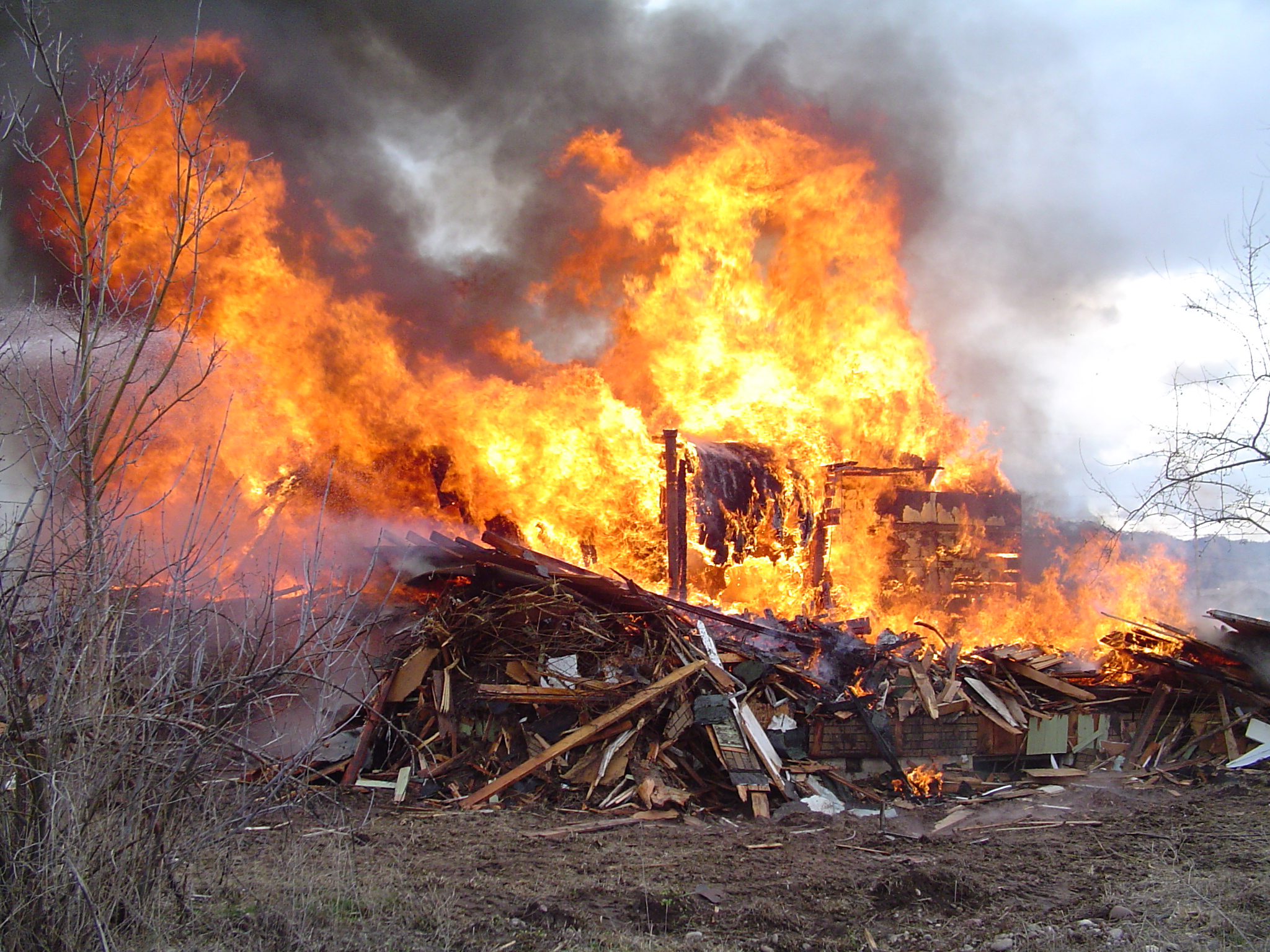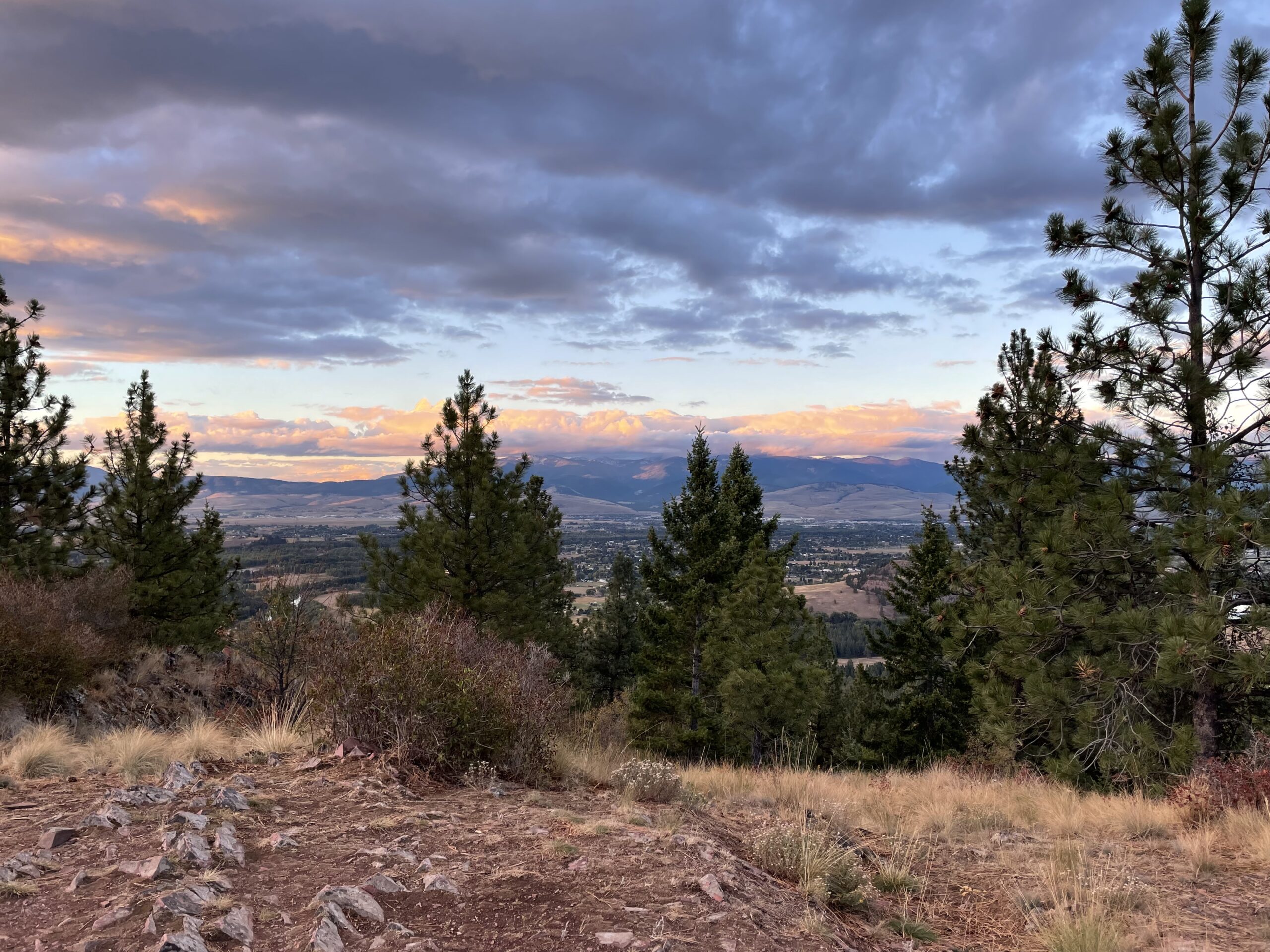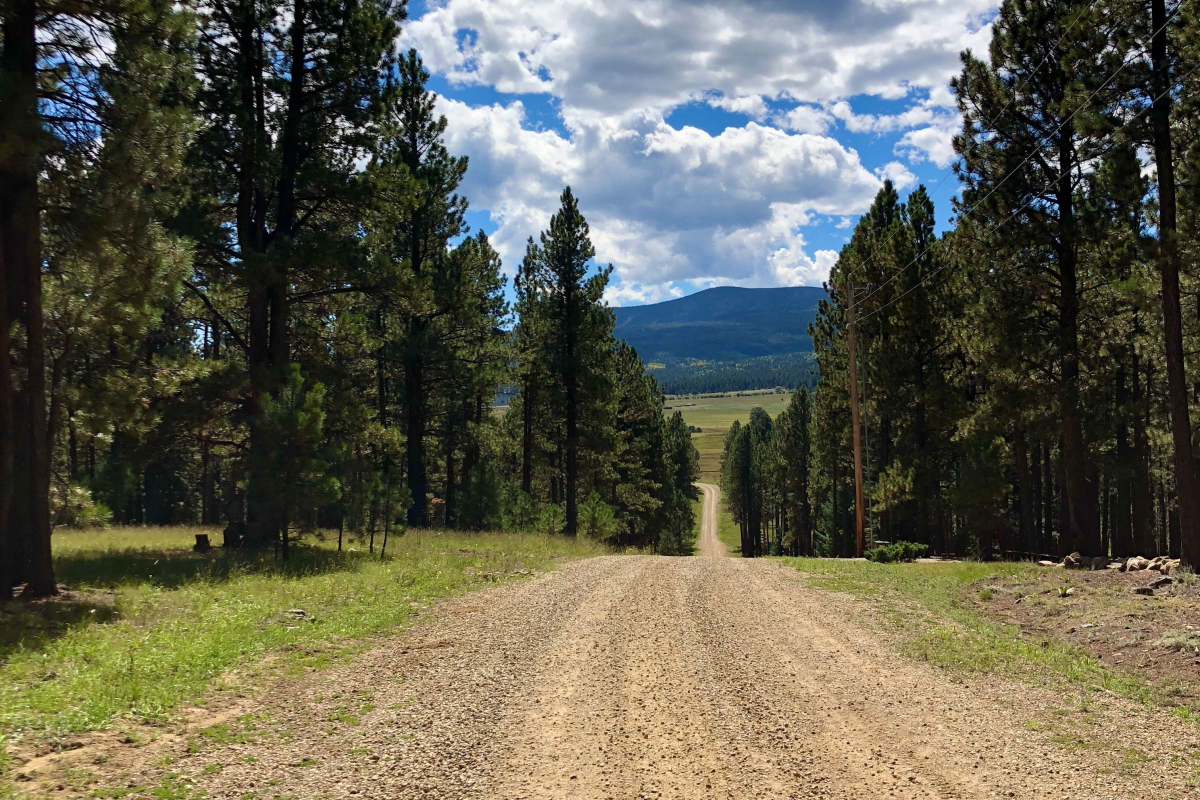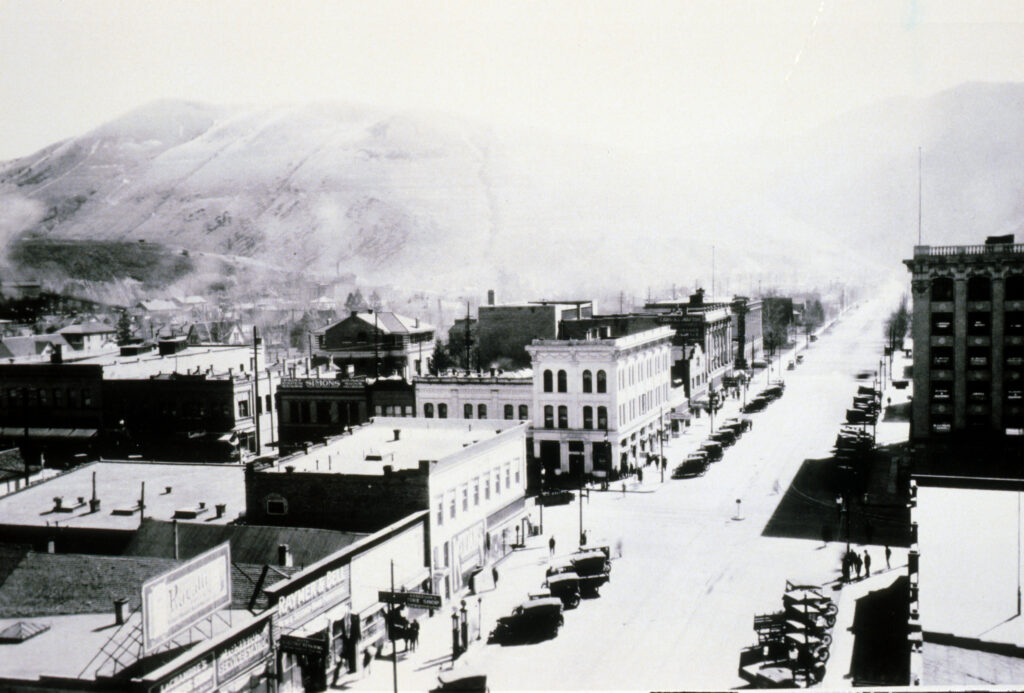Air
Current Air Quality
Wildfire Smoke Update Sept 11, 2024 at 11:30 AM
Wildfire Air Quality Update Sept 10, 2024 – 1:30 PM
Public Notices
11.16.2024 – Public Notice of Preliminary Determination for the Issuance of an Air Quality Permit: Mobile Rock Crushing, LLC
Source: Gravel Crushing Plant Operation
Applicant: Mobile Rock Crushing, LLC
Missoula Public Health (Department) has received a complete application for an Air Quality Permit for a gravel crushing operation at the following location: Section 16, Township 13 North, Range 19 West, Lot 4, Amended Plat Lot 3, south of 1355 Rogers St, Missoula, MT, 59802. Upon review of the permit application and other information, the Department finds that Mobile Rock Crushing, LLC has filed a complete application indicating the proposed facility is capable of meeting applicable requirements of the Air Pollution Control Program.
Therefore, the Department hereby gives notice of the preliminary determination to issue an Air Quality Permit to Mobile Rock Crushing, LLC for a gravel crushing operation. The permit will be issued with several conditions attached. The Department will make a final determination concerning the application on December 2, 2024. Any interested person may review a copy of the application and proposed permit at the Environmental Division of Missoula Public Health, 301 West Alder, Missoula, MT 59802. Written comments on the preliminary determinations will be accepted until November 30, 2024. Comments should be sent to the attention of Taylor Schaeffer, Air Quality Specialist, Environmental Health, 301 W. Alder, Missoula, MT 59802 or email [email protected]. For more information, call (406) 258-4755.
Air Pollution Alerts & Warnings
Air pollution alerts/warnings are in place to limit small particulate matter that can harm lungs with long term exposure leading to increases in asthma. Status will be updated on a banner on this site if a warning or alert are in place.
| When the following is called: | These restrictions are in effect: |
|---|---|
| Stage I Air Pollution Alert | No visible emissions are allowed from any woodstove or other solid fuel burning device in the Air Stagnation Zone without a valid air alert permit. |
| Stage II Air Pollution Warning | No visible emissions are allowed from any woodstove or other solid fuel burning device inside Impact Zone M without a valid sole source of heat permit. |
Paving and Dust Control
This information sheet provides you with an overview of the dust issue in Missoula County and describes for you the available options for addressing road dust issues in your community.
The best and longest lasting way to prevent dust emissions from roads is to pave the road. Current Missoula City-County regulations require all new roads and most driveways in the Air Stagnation Zone be paved and require reasonable precautions be taken to control fugitive particulate emissions from any source or activity.
The Public Works Department estimates that paving costs $100,000 per mile, which means paving all unpaved County Roads would cost approximately $50 million. Since 1995 more than $4 million dollars of Federal Congestion, Mitigation and Air Quality Funds (CMAQ) have been used for paving within the City’s Air Stagnation Zone. Dust abatement costs an estimated $4,000 per mile, which would require a total of $2 million annually to treat all unpaved roads. The total road budget from tax dollars is approximately $1.3 million.
The County continues to look for means to prevent or reduce dust from unpaved roads. Options include increasing the Public Works Department’s share of the county tax dollars, creating Rural Special Improvement Districts and applying for grants when available.
| Options for Addressing Road Dust |
|---|
| 1. Create an RSID for Paving Rural Special Improvement Districts (RSID) can be created to provide funding for improvements and maintenance of infrastructure, such as streets. The funds are generated by all the affected property owners. For citizens to create a Rural Special Improvement District (RSID), at least 60% of the affected property owners must sign a petition indicating their preliminary support. Once the petition is presented to the County Commissioners, a public hearing will be held. The RSID can only be created if less than 50% of the owners in the area protest. For more information on forming an RSID contact 258-4816. |
| 2. Create an RSID for Dust Abatement This is similar to an RSID for paving, but the funds are used for annual dust abatement instead. |
| 3. Hire a Private Firm for Dust Control A third option is to hire a private firm to apply dust suppressant to the road on a one time or annual basis. The money can be collected through private agreements with affected property owners. This can be done on a voluntary basis or through a Homeowner’s Association. On roads the County maintains, a permit is required through the Public Works Department and only approved suppressants are allowed. Through this permitting system the County does road preparation work before the dust suppressant is applied to maximize the dust abatement benefits. For more information on the dust suppressant permitting system contact Public Works at 258-4753. |
| 4. Contact the Western Federal Lands Highway Division If an unpaved road accesses federal land then the Western Federal Lands Highway Division may be interested in the project to provide safe and adequate transportation access to and through federally owned lands. For more information contact them at (360) 619-7700. |
| 5. Traffic Control Options A road surface’s silt and moisture content greatly influence dust emissions. Traffic factors, such as vehicle speed, weight and number of wheels, can also influence dust emissions from unpaved roads. Modifying these factors can influence emissions. State statute requires that an engineering study and “speed limit warrant test” be conducted before a speed limit can be changed. If you believe a speed limit change is warranted on a County road you should put the concern in writing to the Public Works Director, 6089 Training Drive, Missoula 59808.Public Works can produce “Slow Down Dust Hazard” signs as budgets allow. These signs are considered advisory, however, and are not enforceable. Contact Public Works at 258-4753 if interested. Weight restrictions and truck routes can only be established by resolution of the County Commissioners. |
History
Missoula is located in a mountain valley, containing more than 70,000 people. It’s the largest urban area in the United States surrounded by the Rocky Mountains. Because of the mountain valley topography, winter temperature inversions that trap pollution near the valley floor are common.
Air Pollution Control Areas
There are currently three main air pollution control areas in Missoula County: the Missoula Air Stagnation Zone, Impact Zone M, and the Oxygenated Fuel Control Area. Several rules in the Missoula City-County Air Pollution Control Program are specific to one of these areas.
1.1.1 Missoula Air Stagnation Zone
In 1981, the Air Board designated the area surrounding the City of Missoula as the Air Stagnation Zone (MASZ). The geographic area would eventually come to encompass a geographic area that extends roughly four miles outside the city limits (Figure 1.1.1-1). In order to limit air pollution in Missoula’s most densely populated areas, several rules in the Missoula City-County Air Pollution Control Program are specific to the MASZ. These rules restrict solid fuel burning device installations, limit outdoor burning, and mandate paving.
Figure 1.1.1-1 Missoula Air Stagnation Zone
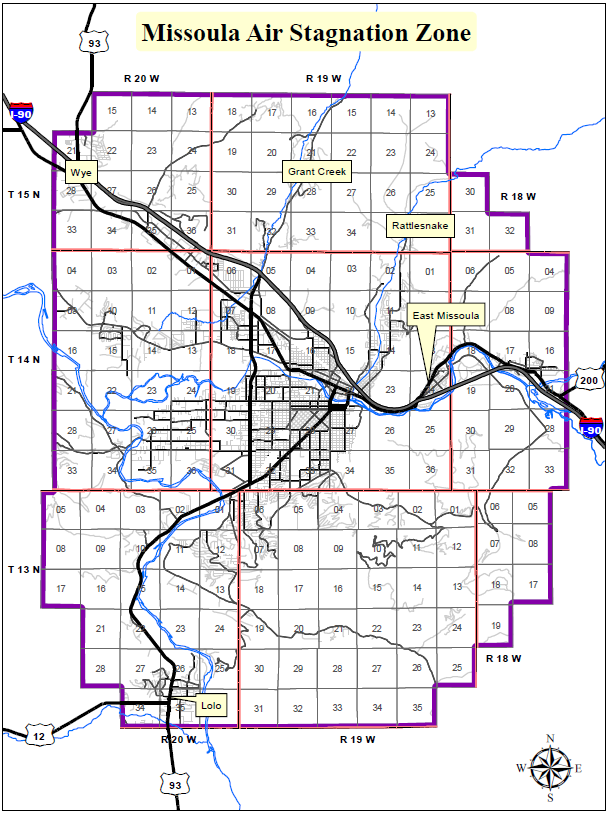
1.1.2 Impact Zones
1.1.2.1 High Impact Zone
In 1983, the Air Board designated the High Impact Zone (HIZ) (Figure 1.1.2.1-1). The HIZ more closely followed the Missoula City limits boundary than the MASZ. Visible emissions from residential solid fuel burning devices were limited or prohibited in the HIZ during high pollution episodes. This prohibition area was later expanded to the entirety of the MASZ in 2010, and the HIZ was phased out.
Figure 1.1.2.1-1 Missoula High Impact Zone
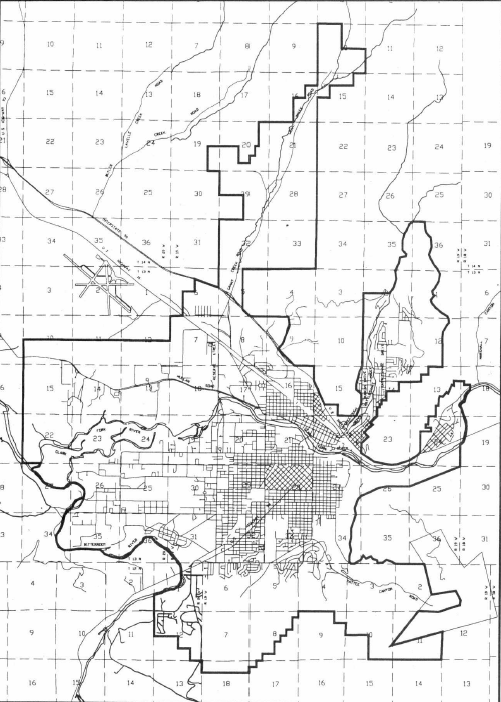
1.1.2.2 Impact Zone M
In 2010, the Air Board designated Impact Zone M – an area that extends well beyond the MASZ boundaries (Figure 1.1.2.2-1). Impact Zone M is primarily used as a tool to limit outdoor burning emission in heavily populated areas, but there are also rules in place that prohibit emissions from solid fuel burning devices in Impact Zone M during air pollution warnings.
Figure 1.1.2.2-1 Impact Zone M
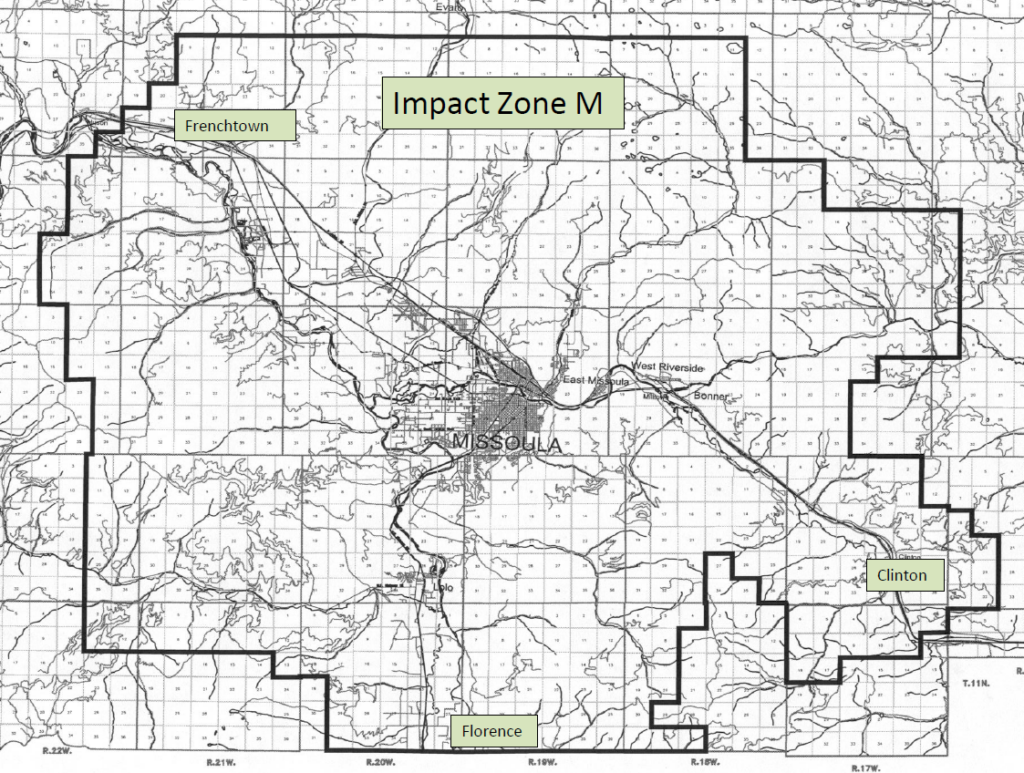
1.1.3 Oxygenated Fuel Control Area
The Air Board adopted the Oxygenated Fuel Control Area (OFCA) (Figure 1.1.3-1) following Missoula’s designation as a carbon monoxide nonattainment area. Inside the OFCA, gasoline intended for use in motor vehicles must be oxygenated in the winter months (November through February).
Figure 1.1.3-1 Missoula Oxygenated Fuel Control Area
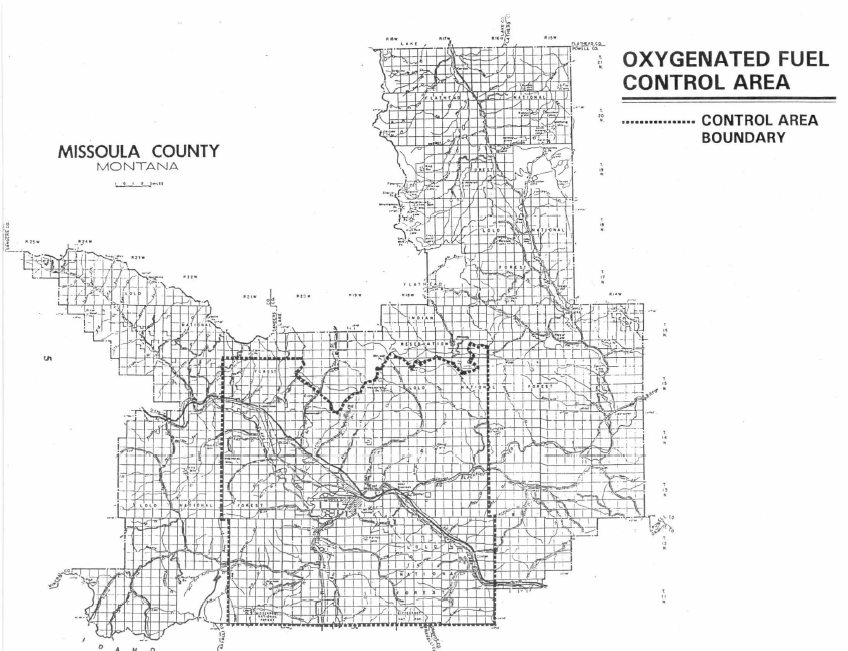
Particulate Air Pollution History
2.1 Total Suspended Particulate
Prior to 1970, industrial sources were largely responsible for the high levels of particulate measured in the Missoula valley. In particular, unregulated industrial wood waste burning at local lumber mills produced large quantities of smoke that became trapped in the Missoula valley. By 1974, however, strict enforcement of emission standards reduced industrial emissions in the valley by more than 90 percent. As a result, Missoula met the Federal annual average ambient air quality standard for total suspended particulate (TSP) in 1973 and again in 1975. However, violations of the daily TSP standard continued during the winter months and the respite from generally poor air quality was short.
After the Arab oil embargo of the 1970s, wood became a popular home heating alternative in Missoula. In 1974 and 1975, local air quality officials found that wintertime particulate levels were increasing and that TSP collection filters were darker in color than those collected earlier in the decade. They suspected residential wood burning as the source of the increased particulate levels and the cause of the darker filters. Table 2.1, a compilation of several residential wood burning surveys, shows that the percentage of people burning wood increased through 1980 before beginning to decline.
Table 2.1: Missoula Residential Wood Burning Trends
| Survey Year | 1977 | 1980 | 1983 | 1986 | 1992 | 1996 |
|---|---|---|---|---|---|---|
| Number of Households | 21.305 | 21.970 | 22,875 | 23,325 | 26,930 | 27,205 |
| Number of Burners | 8,032 | 11,666 | 11,483 | 10,193 | 6,732 | 5,332 |
| % RWB | 37.7 | 53.1 | 50.2 | 43.7 | 25.0 | 19.6 |
| Tons Burned | 25,912 | 54,120 | 40,296 | 33,174 | 22,297 | 15,15 |
| Tons CO Emitted | 2,462 | 5,141 | 6,362 | 6,316 | 3,595 | 1,569 |
| Tons PM10 Emitted | 648 | 1,218 | 1,316 | 1,079 | 608 | 206 |
2.2 PM10
In July of 1987, the U.S. Environmental Protection Agency (EPA) passed a PM10 (particulate matter with an aerodynamic diameter less than or equal to 10 microns) standard that replaced the TSP standard. The PM10 standard is more protective of human health, because the 10 micron and smaller particles can reach into the small airways of the lungs, while the larger particles are trapped and expelled by the body’s defense mechanisms. The 24-hour PM10 NAAQS is 150 µg/m3, not to be exceeded more than once per year on average over a three-year period. The annual PM10 NAAQS was 50 µg/m3, averaged over three years. In 2006, the EPA revoked the annual PM10 NAAQS.
During the winter of 1986/1987, MCCHD conducted a chemical mass balance study (CMB) at Rose Park to apportion the sources of PM10 in the valley (Figure 2.2-1). Residential wood smoke contributed 47% of the PM10 during the study, followed by road dust at 22.6%, motor vehicle exhaust at 10.2% and industry at 7.6%. This study confirmed that residential wood burning had replaced industry as the primary source of particulate pollution in the valley.
Figure 2.2-1. Rose Park PM10 Chemical Mass Balance Study Winter 1986/1987
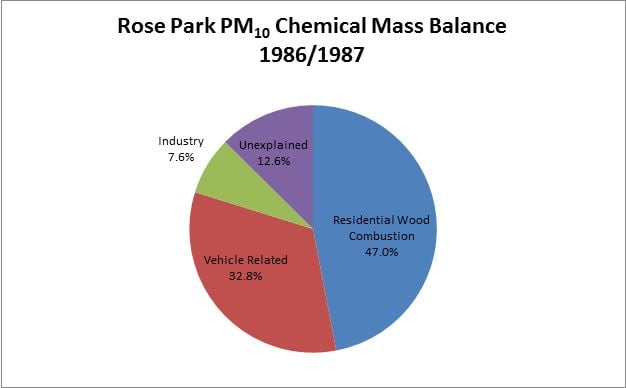
Missoula exceeded the annual average PM10 standard in 1986 and exceeded the 24-hour PM10 standard several times between 1987 and 1989. Because of these exceedances, Missoula was designated a non-attainment area for PM10 and Montana was required to submit a State Implementation Plan (SIP) to the U.S. Environmental Protection Agency by 1990 that included monitoring, emission inventories, chemical analysis of particulate to identify sources, and regulations adequate to meet the PM10 standard in Missoula within three years. This plan was written by the Missoula City-County Health Department.
EPA fully approved the Missoula nonattainment plan in 1995. In the 1980s and early 1990s, Missoula PM emissions were primarily attributed to smoke from residential wood burning and fugitive dust from travel on roads. These sources composed roughly 92 percent of the PM10 emissions in the 1986/87 winter emission inventory that was submitted as part of the 1992 SIP submittal. Point sources were responsible for a small percentage of PM10 emissions. Because road dust and residential wood smoke were the significant PM10 sources, Missoula’s PM10 nonattainment plan included a wood stove removal program, restrictions on wood burning devices that can be installed in the Missoula Air Stagnation Zone, emission restrictions for wood burning devices during Air Pollution Alerts and Warnings, paving requirements for new roads, driveways and parking lots, and requirements to reduce silt loading on paved roads by addressing sanding and chip sealing standards as well as street sweeping and deicer requirements.
As a result of all the community work and effort that has gone into reducing particulate emissions, Missoula has not violated a federal particulate standard since 1989.
Figure 2.2-2. Maximum 24-hour average PM10 concentrations (without wildfire data) at the Boyd Park monitoring site in Missoula, MT.
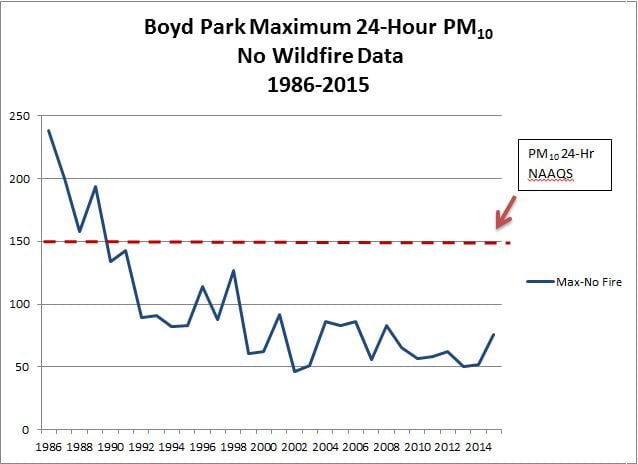
Figure 2.2-2 illustrates the dramatic decrease in Missoula’s human-caused PM10 pollution since the 1980s. These decreases have come about because of a community-wide effort to control and reduce emissions from road dust, residential wood burning and industry. Because winter inversions that trap pollutants near the ground are typical of mountain valley topography, most control measures have been aimed at reducing winter PM10 emissions.
In the summer, human-caused PM10 pollution typically includes road dust, construction fugitive emissions and smoke from outdoor burning. However, because dispersion conditions in the spring and summer months are typically good to excellent, these sources generally have minimal impact on Missoula’s air quality.
It is important to note, however, that summer wildfires regularly contribute to the worst air pollution days in Missoula. Since the 2000, wildfires have grown more severe, and wildfire season can last into late September and early October. Figure 2.2-2 omits wildfire data in order to accurately display the impacts Missoula’s Air Pollution Control Program has had on reducing human-caused particulate pollution.
In the winter of 1995/1996, Missoula performed another CMB study to see if the apportionment of particulate had changed since 1987 (Figure 2.2-3). The most striking differences between the two studies were that the average PM10 levels decreased from 107 µg/m3to 58.8 µg/m3, and the contribution from residential wood combustion decreased (from 47% to 10.5%), while the contribution from road dust and other vehicle-related emissions increased from 32.8% to 64.8%.
Figure 2.2-3. Boyd Park PM10 Chemical Mass Balance Study Winter 1995/1996
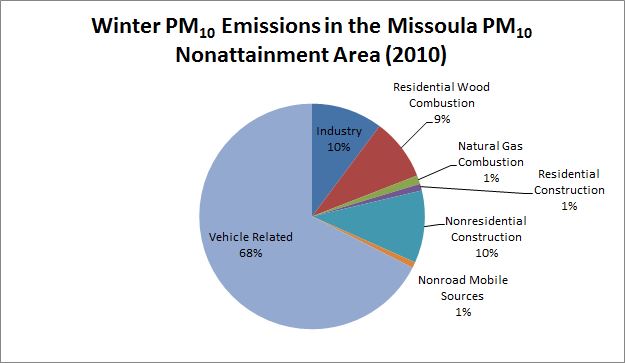
Vehicles continue to be the primary source of PM10 in Missoula. A winter 2010 PM10 emission inventory estimated that vehicles contribute 68% of Missoula’s winter PM10 via road dust and exhaust, tire wear and brake wear (Figure 2.2-4).
Figure 2.2-4 Winter PM10 Emissions in the Missoula PM10 Nonattainment Area (2010)
Based on decades of proven compliance with the PM10 NAAQS, in 2016, the Missoula City-County Health Department submitted a redesignation requested and limited maintenance plan to the EPA, requesting to be redesignated as in attainment for PM10. The EPA has indicated they will consider the request in fall 2017. Once redesignated, Missoula will enter a 20-year maintenance period for PM10.
2.3 PM2.5
In January of 1999, Missoula began monitoring for PM2.5 – particulate matter with an aerodynamic diameter less than or equal to 2.5 microns. The EPA promulgated national ambient air quality PM2.5 standards on July 18, 1997 to address concerns that the PM10 standards did not adequately protect human health. Because of PM2.5’s smaller size, it can penetrate further into small lung airways, and can even enter the bloodstream. These particulates aggravate asthma and lead to decreased lung function, increased respiratory symptoms, and have been linked to premature death in people with heart or lung disease. PM2.5 is a product of incomplete combustion, and its primary sources in Missoula are residential wood combustion in the winter and wildfires in the summer.
The federal 24-hour standard for PM2.5 was initially designated as 65 µg/m3, not to be exceeded more than six days per year, and the annual average standard was 15 µg/m3. As studies continued to illuminate the dangers of exposure to PM2.5, the federal particulate standards began to tighten. In 2006, the EPA lowered the PM2.5 24-hour NAAQS to 35 µg/m3. Then, in 2012, the EPA lowered the annual PM2.5 NAAQS to 12 µg/m3.
Figure 2.3-1 shows characteristic PM2.5 peaks in the winter and summer months.
Figure 2.3-1– 24-Hour PM2.5 Averages at Boyd Park in Missoula (2009-2015)
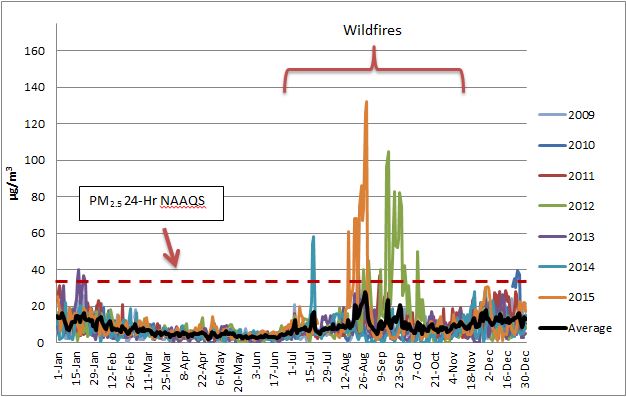
2.3.1 Winter PM2.5
In the winter months, PM2.5 in Missoula comes primarily from combustion sources such as woodstoves, vehicle exhaust and industrial boilers. It also includes secondary particulate, such as ammonium nitrate. Ammonium nitrate forms in the atmosphere from ammonia (NH4+) and nitrate (NO3–). Nitrate is primarily released by combustion sources such as vehicles and natural gas heaters. In the winter of 2006/2007, a chemical mass balance study attributed Missoula’s PM2.5 sources primarily to residential wood combustion (55%), ammonium nitrate (18%) and industry (19%) (Figure 2.3.1-1). However, shortly after the CMB was conducted, several local major industries shut down, which means residential wood combustion likely makes up an even larger part of the pie at this time.
Figure 2.3.1-1. Boyd Park PM2.5 Chemical Mass Balance Study Winter 2006/2007
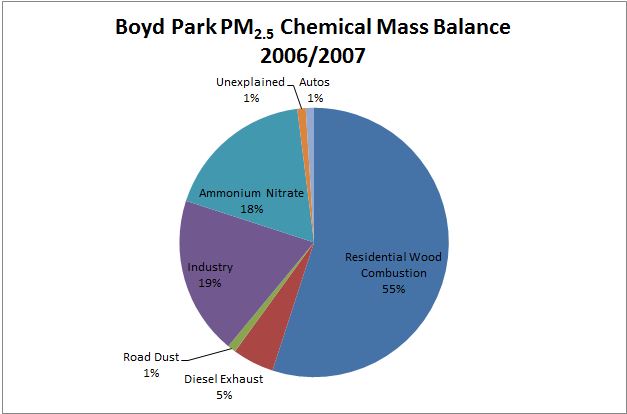
Because residential wood combustion is the primary source of winter PM2.5 pollution, regulations that require the removal of woodstoves in the Missoula Air Stagnation Zone (MASZ) and prohibit the installation of woodstoves or fireplaces in the MASZ, has led to steady improvements in winter air quality. Figure 2.3.1-2 shows the Missoula trend of decreasing PM2.5 in the winter months, as well as wildfire spikes in the summer months. Figure 2.3.1-3 illustrates the gradual decline of winter PM2.5 concentrations in Missoula. However, it is important to note that while, in general, Missoula is attaining the PM2.5 NAAQS, most winters still see occasional exceedances of the 24-hour standard, and a prolonged winter inversion could potentially tip the area into nonattainment. In 2007, Missoula’s design value for PM2.5 was 35.2 µg/m3– nonattainment status was avoided by the mathematical convention of rounding down. Figure 2.3.1-4 illustrates Missoula design-values for PM2.5 24-hour concentrations. Design values are based on a three-year rolling average of the 98th percentile 24-hour PM2.5 concentration. Design values are compared to the NAAQS to determine an area’s compliance with federal standards.
Figure 2.3.1-2. Missoula Monthly Average PM2.5 24-hour Concentrations (2000-2015)
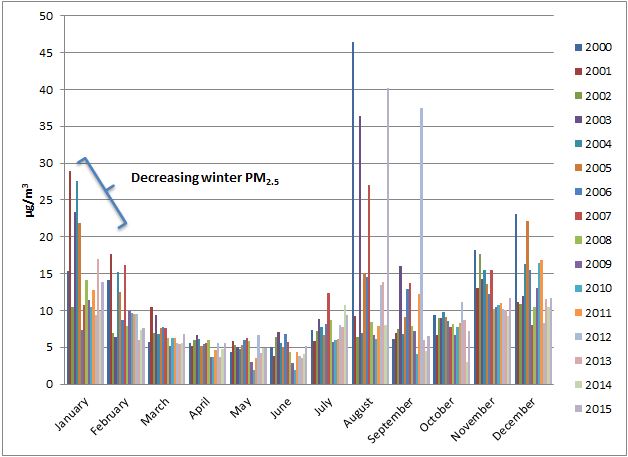
Figure 2.3.1-3 Missoula Winter (Nov.-Feb.) Average 24-hour PM2.5 Concentrations, 1999-2015

Figure 2.3.1-4 Missoula 24-Hour PM2.5 Standard Design Values with Wildfire Data Omitted (2005-2013)
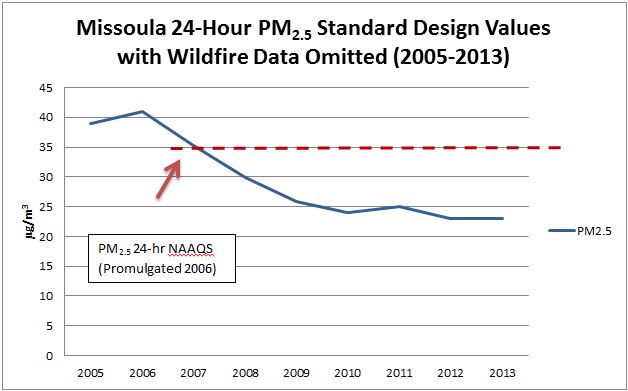
2.3.2 Seeley Lake
Outside the MASZ, many Missoula County residents continue to rely on wood heat. In Seeley Lake, a small mountain valley community north of Missoula, smoke from woodstoves has led to a large number of poor air quality days.
The Seeley Lake valley, like many areas in western Montana, is prone to frequent temperature inversions that have the potential to trap smoke from woodstoves near the ground where it poses a threat to human health.
The Missoula City-County Health Department (MCCHD) and Montana Department of Environmental Quality (MDEQ) first started measuring fine particulate concentrations in Seeley Lake in 2005. During that initial monitoring period, 24-hour PM2.5 concentrations greater than the daily 2006 NAAQS were measured at the Seeley Lake Fire Hall. In 2009, based on the results of the 2005-2007 study, the MCCHD and the MDEQ installed a new continuous PM2.5 monitor in Seeley Lake. This permanent PM2.5 beta-attenuated monitor (BAM) was installed near the Seeley Lake Elementary School (School) at a location meeting all EPA siting criteria. The elementary school BAM PM2.5 monitor is also centrally located in a residential area where many of the homes are heated with wood-burning appliances. The BAM reports hourly data on a near-real time basis and provides MCCHD and the local community near-real time information about Seeley Lake’s air quality.
Shortly after the new monitor’s installation, it became clear that there was a large discrepancy between the two sites. The particulate pollution at the elementary school was frequently more than twice the pollution levels at the fire station (Figure 2.3.2-1). In addition, within a month and half of commencing monitoring at the elementary school, 19 days had daily PM2.5 averages greater than the 24-hour NAAQS of 35 μg/m3. Between January 1 and March 18, 2010, 21 days exceeded the PM2.5 24-hour NAAQS. For the 2010-2011 winter (November-February), 50 days with PM2.5 concentrations greater than 35 μg/m3 were measured, and for the 2011-2012 winter, 54 days with PM2.5 concentrations greater than 35 μg/m3 were measured.
Figure 2.3.2-1 Fire station and elementary school site comparison (February 2010)
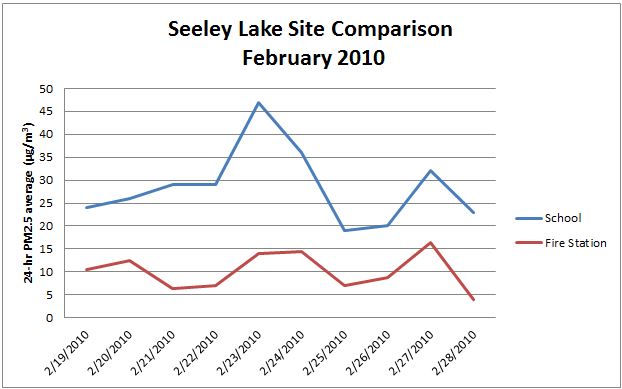
In the winter of 2010/2011, the MCCHD, in conjunction with the MDEQ, conducted a saturation study in Seeley Lake to determine the extent of the winter PM2.5 pollution. In addition to the permanent monitor at the elementary school, temporary monitors were positioned in nearby densely populated neighborhoods (the Dogtown site south of Pyramid Mountain Lumber Inc. and the site on the corner of Juniper and Alder), near a local industrial source (on Boy Scout Road adjacent to Pyramid Mountain Lumber, Inc.) and on the outskirts of town (the Forest Service, Airport, and Barn sites). The results showed a high number of days exceeding the PM2.5 24-hour NAAQS in Seeley Lake neighborhoods, with the most significant pollution centered around the elementary school (Table 2.3.2-1). In addition, the monitors showed pollution levels typically spiking in the early morning hours (Figure 2.3.2-2). Based on visible observations of heavy woodstove smoke, and a history of woodstoves contributing to mountain valley PM2.5 pollution, extensive residential wood combustion was identified as the source of Seeley Lake’s winter PM2.5.
Table 2.3.2-1. Seeley Lake saturation study days exceeding the PM2.5 24-hour National Ambient Air Quality Standard
| Forest Service | Airport | Barn | Boy Scout Rd | DogTown | Juniper & Alder | School | |
|---|---|---|---|---|---|---|---|
| October | 0 | 0 | 0 | 0 | N/A | 0 | 0 |
| November | 1 | 0 | 1 | 3 | 5 | 8 | 8 |
| December | 1 | 1 | 1 | 3 | 7 | 9 | 19 |
| January | 0 | 0 | 0 | 1 | 1 | 9 | 13 |
| February | 0 | 0 | 0 | 0 | 2 | 6 | 7 |
| March | 0 | 0 | 0 | 0 | 0 | 2 | 3 |
| Total | 2 | 1 | 2 | 7 | 15 | 34 | 50 |
Figure 2.3.2-2 Hourly PM2.5 concentrations at the Seeley Lake Elementary School – selected dates, winter 2010-2011
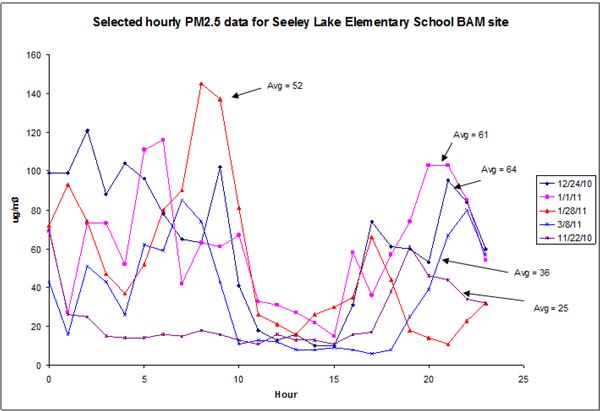
In 2010, the MCCHD, with the help of several community members, began raising funds to start replacing inefficient woodstoves with low-emission EPA-certified stoves. By the winter of 2014/2015, more than 160 stoves were exchanged, and significant progress was made in improving air quality in the Seeley Lake Valley (Figure 2.3.2-3). Missoula County now has an electronic sign in place at the Seeley Lake Elementary School to display air quality data and messages encouraging proper woodstove use. MCCHD continues to work with the community to lower wood smoke pollution.
Figure 2.3.2-3 – Number of Winter Days that Exceed the Federal PM2.5 Standard in Seeley Lake (2010-2015)
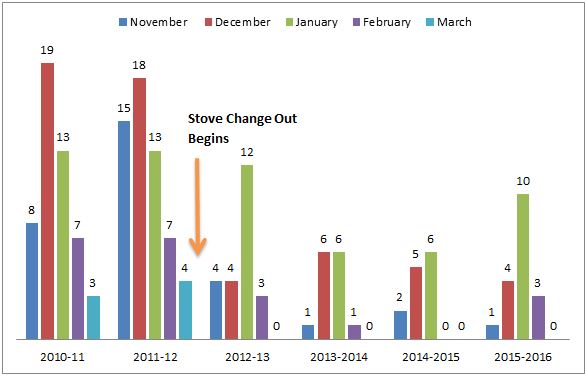
2.3.3 Summer PM2.5
Due to the changing climate, wildfire season has become longer and more severe in the western United States. Wildfires are burning more acreage and causing more severe damage than they were in the 1980s and early 1990s. During a bad wildfire year, smoke from these fires is the source of Missoula County’s most significant PM2.5 pollution. Since MCCHD began monitoring PM2.5, the worst wildfire years were 2000, 2003, 2007, 2012 and 2015. Figure 2.3.3-1 illustrates summer wildfire smoke in Missoula from 2000 through 2015.
MCCHD issues health advisories during wildfire smoke events and works with state agencies to develop guidance for schools and child care facilities.
Figure 2.3.3-1 Missoula Wildfire Season 24-hour PM2.5 Concentrations, 2000-2015

2.3.4 Projected Trends
Overall, PM2.5 pollution in the Missoula urban area and Seeley Lake is on a downward trend (See Figures 2.3.1-2, 2.3.4-1 and 2.3.4-2). This is due to the reduction of residential wood smoke and corresponding improved winter air quality. Figure 2.3.4-2 omits wildfire data in order to illustrate the improvement in winter air quality. However, wildfire smoke is a continual summer threat, and the wildfire smoke events will continue to adversely impact public health.
Figure 2.3.4-1 – Missoula Annual Average PM2.5 Concentrations 2000-2015

Figure 2.3.4-2 Missoula Annual Average PM2.5 Concentrations, No Wildfire Data (2000-2015)

Carbon Monoxide Air Pollution History
Carbon monoxide (CO) is a colorless, odorless gas that acts as a chemical asphyxiant. In high doses, CO exposure causes death. Symptoms of CO poisoning include dizziness, nausea and impaired mental function. CO is released during combustions of organic materials such as fossil fuels and wood.
Missoula was designated as a nonattainment area for carbon monoxide by the U.S. EPA in 1978 following the promulgation of the 1977 amendments to the Clean Air Act. The NAAQS for CO is 9 parts per million (ppm) for an 8-hour average concentration, not to be exceeded more than once per calendar year. Missoula’s violations of the CO NAAQS were attributed primarily to motor vehicle emissions and residential wood combustion.
The designation was based on the results of one year of monitoring at the corner of Brooks Street, South Avenue, and Russell Street (Malfunction Junction). On August 14, 1981, Montana submitted a revised carbon monoxide SIP which was based on reconstruction of Brooks Street and anticipated emission reductions from federal emission requirements on new motor vehicles. An analysis of these control strategies indicated that attainment would be achieved by 1987.
The reconstruction of Brooks Street with minor changes at the intersection was completed in 1985. However, violations of the carbon monoxide standard continued at the Malfunction Junction air monitoring site. Consequently, the EPA notified Montana on May 26, 1988 and again on September 7, 1988 (53 FR 34505) that the Missoula carbon monoxide SIP was substantially inadequate. As a result, Montana was required to complete SIP development activities including a 1988 base year carbon monoxide emission inventory (submitted November 30, 1989). The inventory showed that transportation sources were the primary source of winter carbon monoxide emissions.
The 1990 Federal Clean Air Act (CAA) designated CO nonattainment areas as moderate or serious. Based on monitoring at the Brooks/South/Russell intersection from 1986 through 1988, Missoula was classified as a moderate nonattainment area for CO. As a result, the EPA required Missoula to implement an oxygenated fuels program and to submit a 1990 base year carbon monoxide emission inventory by November 15, 1992. The inventory indicated that motor vehicles were responsible for 63.8% of the winter carbon monoxide emissions, residential wood combustion contributed 26.1% and industrial sources contributed 9.6% of the carbon monoxide emissions.
CO concentrations dropped precipitously following the implementation of the oxygenated fuels program, and continued to plummet as the vehicle fleet became more efficient. Missoula last exceeded the CO NAAQS in 1991 (Figure 3.0-1).
A 1992 CO saturation study confirmed that the Brooks/South/Russell intersection had the highest concentrations of carbon monoxide in Missoula. As a result, Missoula’s CO monitoring site was located at the Brooks/South/Russell intersection and efforts to reduce CO concentrations were targeted at that intersection.
Until 1998, Missoula monitored CO at the Malfunction Junction year-round. However, once it was well established that the maximum CO concentrations occurred only in the late fall and winter, Missoula was able to reduce its monitoring to the first and last quarter of the calendar year (January through March and October through December, respectively). Missoula ceased monitoring ambient CO in 2011 due to extremely low ambient CO concentrations (Figure 3.0-1).
Figure 3.0-1 Missoula 2nd Maximum 8-Hour CO Average (1987-2011)

In 1992, as one of 41 cities across the nation that did not meet federal CO standards, Missoula received almost $30 million in federal transportation funding, called Congestion Mitigation Air Quality (CMAQ) funding, to spend over the next five years. In 1993, the Brooks/South/Russell intersection was identified as one of the projects to receive CMAQ funding. The City undertook a long and involved process to find a solution the community would accept and that would solve the congestion and air quality problems at Brooks/South/Russell. Many alternatives were explored, including an overpass, an underpass, various roundabouts, system improvements to surrounding arterials, traffic demand management, an urban interchange, and a combination of an overpass or underpass with system improvements. Most of these alternatives were rejected because they would not solve the air quality problem at the intersection. The overpass alternative, which would significantly reduce the CO at the intersection, was overwhelmingly rejected by the public. Finally, the city settled on an at-grade realignment of South Avenue. The City Council held a public hearing in September of 1997 and approved the project in October 1997. In April 1999, the City Council and the community reaffirmed its commitment to the project with the hiring of a contractor for the final design.
Air quality modeling showed that, given worst case meteorological conditions, Missoula would exceed the national ambient air quality standards for CO if nothing was done at the intersection. However, with the project, Missoula would continue to attain the standard with current controls at least through 2015.
The massive realignment project was completed in 2005 to simplify the Brooks/South/Russell intersection. The realignment project simplifies the intersection and reduced the projected peak-hour delay from 120 seconds to 20 seconds. It also allows better synchronization of all traffic lights along Brooks Street from Reserve to Mount, which helps reduce congestion along the entire corridor.
Also in 2005, since Missoula had more than three years of monitoring with no exceedances of the national standards, Missoula applied for redesignation as an Attainment Area for CO. The redesignation request addressed the five criteria required by Section 107(d)(3)(E) of the CAA, as follows:
Criterion 1: Attainment of the Applicable National Ambient Air Quality Standard
Criterion 2: State Implementation Plan Approval
Criterion 3: Permanent and Enforceable Improvements in Air Quality
Criterion 4: Fulfillment of CAA Section 110 and Part D Requirements
Criterion 5: Fully Approved Maintenance Plan under CAA Section 175A
The U.S. EPA approved the request in 2007 and Missoula entered a 20-year maintenance period for carbon monoxide.
During the redesignation process, various individuals and groups in the Missoula community pointed out that Missoula had grown and changed since the 1992 CO saturation study and that CO concentrations on the Reserve Street corridor may be higher than those at Malfunction Junction. Since 1992, Reserve Street has grown from a two-lane road into a busy four-lane highway with major commercial development along most of the corridor. Traffic count data show that Reserve Street has become the busiest road in Missoula. In response to these concerns, the Missoula Air Pollution Control Board requested that the Missoula Health Department conduct a winter 2005/2006 CO study along the Reserve Street corridor.
The primary purpose of the study was to verify that Missoula was in compliance with the CO National Ambient Air Quality Standards by measuring for CO at Reserve Street, where concentrations were expected to be highest. The other purpose of the study was to compare CO levels between Malfunction Junction, which was restructured in 2005 prior to the study, and the Reserve Street corridor. Missoula’s permanent CO analyzer is also located at Malfunction Junction.
The main focus of the study was near the major Reserve Street intersections because vehicles are the primary source of CO in Missoula and CO concentrations are higher at intersections where large numbers of vehicles idle, accelerate and stop. Vehicles produce more CO when they stop, start and idle than they do when cruising at a steady speed. In addition, CO concentrations are higher in the winter time because temperature inversions trap cold air and pollution on the valley floor and cold vehicles produce more CO.
The saturation study examined CO concentrations at six intersections along Reserve Street in the winter of 2005/2006. The study found that CO concentrations along Reserve Street were relatively comparable to CO levels at Malfunction Junction intersection. The greatest CO concentration measured during the saturation study was 2.9 ppm – well below the 8-hour NAAQS of 9 ppm. A point of interest was that the highest CO concentrations measured during the study were always on the east side of the road. It has been noted that under stagnant conditions, a circular air movement may set up in the Missoula Valley which would cause air to drift to the west on the most northerly part of Reserve Street and east on the southern part of Reserve Street. One of the drivers of the circular pattern could be the air that drains out of Hellgate Canyon into the northeast corner of the valley. While this eastward CO drift presents many interesting questions, we conclude that from a public health perspective further study is unnecessary because of the low CO concentrations found.
The 2005 Missoula CO Redesignation Request included a full maintenance plan as required by the CAA for moderate nonattainment areas. However, CO levels in Missoula have dropped precipitously since the area was classified as a “moderate” nonattainment area in 1990. Between 2006 and 2011 (the most recent 5 years of CO data), the maximum CO 8-hour concentration was 4.1 ppm – well below the NAAQS. Because of this reduction in CO levels, the EPA agreed Missoula could submit a limited maintenance plan (LMP) for the last 10-years of the maintenance period.
In 2016, MCCHD submitted the Missoula County Carbon Monoxide Second 10-Year Limited Maintenance Plan to the EPA. As part of the submission packet, MCCHD conducted a carbon monoxide emission inventory for a winter day in 2010. The inventory illustrated that motor vehicles continue to be the primary source of CO in Missoula (Figure 3.0-2).
Figure 3.0-2 Missoula Carbon Monoxide Emission Inventory (Winter 2010)
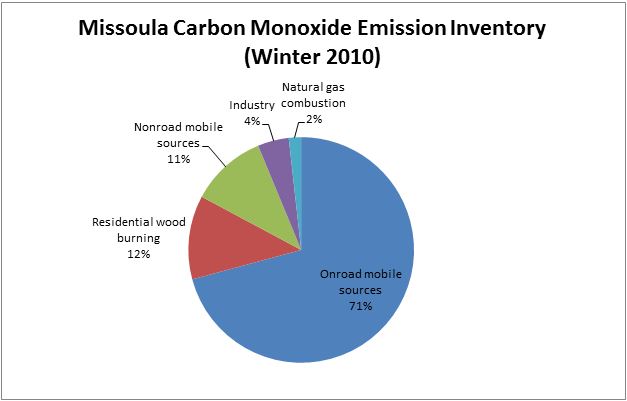
The LMP retains all of the control and contingency measures that were included in the intial redesignation request and maintenance plan. This document fulfills the requirements of Missoula’s redesignation as in attainment for carbon monoxide.
Health Studies
In 1977, the Montana State Legislature funded the Montana Air Pollution Study (MAPS) to evaluate the impacts of air pollution on a state-wide basis. A major portion of the funding went into health effects studies to determine whether air pollution affects school children and those adults with chronic obstructive pulmonary diseases, such as asthma, emphysema and chronic bronchitis.
In 1978 and 1979, third and fourth graders in Great Falls, urban Missoula and outlying rural and low-density suburban areas near Missoula were given pulmonary function tests (PFTs). The annual average total suspended particulate (TSP) in Great Falls was 42 µg/m3compared to Missoula’s 81 µg/m3. The TSP levels in the outlying areas near Missoula were one third to one half the levels found in urban Missoula. In all PFT comparisons, with one exception, the children from the lower TSP communities exhibited better pulmonary function than those from urban Missoula. Children exhibited the greatest differences when medium and small airway resistance was measured, which confirmed that small air passages are the most sensitive to air pollution effects.
MAPS also funded a study which compared school children’s lung functions to different air pollution levels within one community. In 1978-79 and again in 1979-80, Missoula third and fourth graders were given a series of pre-scheduled PFTs, which were then correlated with pollution levels. During both years, the children exhibited decreased pulmonary function as particulate levels increased.
During 1979‑80, 84 adults with chronic obstructive pulmonary diseases underwent monthly pulmonary function testing. These subjects kept diaries of their daily symptoms and activity levels. The researchers compared the PFT and diary data to TSP levels by regression analysis. As particulate levels increased, all PFT parameters and activity levels decreased. In addition, with increased pollution levels, four of five morbidity symptoms increased.
The results of the MAPS studies suggest that TSP similar to that found in Missoula during the winter causes measurable health effects upon the human pulmonary system and upon small airways in particular. Dr. Kit Johnson, Director of the MAPS Health Effects Study, concluded, “Possibly these changes are reversible and short‑term and may not lead to significant permanent lung damage in the majority of individuals. However, the long‑term effects are not known, and the effects upon the growing lungs of children less than five or six years old are unexplored.” Even with these uncertainties, there is no doubt that high pollutant levels make breathing and other normal activities more difficult for those who have asthma, chronic bronchitis, emphysema and other disorders of the pulmonary system.
MAPS also evaluated the relative carcinogenicity (cancer causing potential) of particulate in ten Montana cities. Monthly samples were taken in each town for a year and analyzed for organic mutagen content. The ten cities ranked as follows in decreasing order of the number of mutagen equivalents present: Missoula, Billings, Kalispell, Butte, Libby, Bozeman, Anaconda, Great Falls, Decker, and Scobey.
At first glance, it was surprising that Missoula, which doesn’t have any industries that are considered traditional sources of organic carcinogens, would rank highest on the list. It wasn’t like Billings, a town with oil refineries, which researchers expected to rank high. Further inspection of the test results showed that, with the exception of Billings, the other top five ranking towns exhibited high levels of mutagens during the winter and relatively low concentrations during the summer. These towns are all located in western Montana where wood is readily available and commonly used by industry and residents for heating. An analysis of the combustion products of wood smoke indicated that sufficient carcinogens are present to explain the results of the Montana mutagen study.
Oxygenated Fuels
SEPTEMBER 15, 2022 UPDATE:
In anticipation of being given the approval by EPA to cease the oxygenated fuels program and suspend the rules as early as November 2022, the Missoula City-County Air Pollution Control Board directed the department not to collect registration fees or fund the oxygenated fuels program for the winter of 2022-2023. Due to lack of funding, the Board gives notice to the public that the department will not have the resources to monitor or enforce the requirements of the oxygenated fuel program this winter.
Read the resolution here.
As a result of the 1977 amendments to the Clean Air Act (CAA), Missoula was designated nonattainment for carbon monoxide (CO) by the U.S. Environmental Protection Agency (EPA) in the Federal Register (FR) notice (43 FR 9010) on March 3, 1978. The National Ambient Air Quality Standard (NAAQS) for CO is 9 parts per million (ppm) for an 8-hour average concentration, not to be exceeded more than once per calendar year. Missoula’s violations of the CO NAAQS were attributed primarily to motor vehicle emissions and residential wood combustion. The community took several steps to reduce the ambient levels of CO, including reconfiguring traffic intersections to relieve congestion and implementing rules to limit emissions from residential wood combustion and outdoor burning. Missoula continued to violate the NAAQS until the early 1990s.
Following the promulgation of the Clean Air Act Amendments of 1990, EPA classified Missoula as a moderate nonattainment area for CO (56 FR 56694) based on a design value of 9.7 for 1987 through 1989. This designation required Missoula to develop a new base year inventory for 1990 and establish an oxygenated fuel program by November 1992. In June 1992, Missoula incorporated an oxygenated fuels program into the Missoula City-County Air Pollution Control Program. It was approved by the Montana Board of Environmental Review (BER) in September 1992, and implemented that November. On November 6, 1992, the Governor of Montana submitted the oxygenated fuels program to EPA for approval. Since implementing the oxygenated fuels program, Missoula has not violated the CO NAAQS.
The oxygenated fuel season runs November 1 through the end of February of each winter. During this season, all gasoline used to fuel motor vehicles within the control area must be oxygenated.
What is carbon monoxide?
Carbon monoxide (CO) is a clear, odorless gas emitted by inefficient combustion of any type of fuel. It interferes with the body’s ability to carry oxygen in the bloodstream from the lungs to all parts of the body. Low levels of CO in the bloodstream can cause headaches, loss of concentration, and slowed reaction time. At higher concentrations it can be life threatening, especially for expectant mothers and small children, and people with asthma, emphysema, or circulatory problems. Even healthy people who are exercising on high pollution days can also be adversely affected.
What is ethanol?
Ethanol intended for fuel is usually produced from grains such as corn, wheat, and barley, and results from a fermentation process. About two and a half gallons of ethanol can be produced from each bushel of corn. A by-product of the process is used as cattle feed. When it is added to gasoline at the concentration of 8% by volume, it will increase the octane level by about 2 points. So if the octane rating listed on the gas pump is 87, gasoline containing ethanol will have an octane rating of about 89, which results in the equivalent of a premium grade of gasoline.
How will oxygenated fuel affect vehicle performance?
Because the addition of oxygenates to gasoline increases the octane rating of gasoline, vehicle performance will generally increase somewhat. Because the performance increases, gas mileage may drop but usually only by less than two percent. Cold temperatures and wintertime driving conditions tend to lower gas mileage by more than this amount.
Will using oxygenated fuels void the vehicle warranty?
No, all major vehicle manufacturers warranties remain in effect when using fuels oxygenated with ethanol. In fact some manufacturers recommend using higher octane fuels to obtain the performance characteristics the engine was designed for. Some manufacturers caution against using methanol or wood alcohol as a fuel additive because of its corrosive nature. No gasoline blender in Missoula will be using methanol as an oxygenate.
How will oxygenated fuel affect older vehicles?
Older vehicles, especially pre-1975 models, may have parts such as gaskets with elastomers, which are more susceptible to swelling or degradation when using alcohols and ethers in gas. These parts are also affected by other aromatic compounds added to gas in recent years because of the lead phase-out in gasoline. All of today’s gasoline, with or without oxygenates, is generally more aggressive towards fuel system materials than it was 10 to 15 years ago.
What about ethanol and filter plugging?
Ethanol can act as a solvent for contaminants that often build up in gasoline tanks. The gas station may need to change the pump filter after the first load of fuel has been delivered and the same may be true after your vehicle’s first tank full of ethanol gasoline. After that, fuel filters will not have to be changed more often than is recommended by the vehicle manufacturer. The cleansing effect of ethanol will be beneficial for removing deposits and keeping carburetors and fuel injectors free from dirt and deposits.
What about water separating out of the gasoline?
When ethanol is blended with gasoline and used in small engines, water absorbed from the outside air can cause the ethanol and water mixture to separate from the gas and sink to the bottom of the gas tank. This should not be a problem unless gas is stored for a long period of time where it has the ability to absorb water to over half a percent. To help avoid condensation of water in gasoline that is stored, use containers with tight fitting caps. Gasoline should not be used if it has been allowed to sit for extended periods of time. Because ethanol has the ability to absorb water, consumers will not need to add gas line antifreeze to their gas tanks in order to prevent fuel line plugging due to ice crystal formation.
What about the use of oxygenated fuels in small specialty engines?
Engines found in chain saws, snowmobiles, powerboat engines, etc. may have elastomers, which are more susceptible to degradation when alcohols and ethers are used in gas. When in doubt consult the engine manufacturer. In 1988 tests were done on chain saws, weed trimmers, portable generators, blower/vacs, lawn mowers, and water transfer pumps from seven different manufacturers using a 10% ethanol blend of fuel. After more than 1,300 hours of operation to simulate four to five seasons of use, not one failure occurred. The engines were disassembled, inspected, and compared to engines that used unleaded fuel. The test authors noted that no service or repairs (beyond the manufacturer’s recommendation) were necessary. Evinrude, Tecumseh, Sears, Briggs & Stratton, and Ski-doo Snowmobiles have all indicated that gasoline blended with ethanol is suitable for use in their products.
Local Strategies to Improve Air Quality
5.1 Residential Wood Combustion
In less than a decade, Missoula’s major source of air pollution shifted from six industrial sources to approximately 20,000 residential woodstoves and fireplaces. The shift occurred because Missoulians wanted to save on rising fuel bills while reducing dependence on fossil fuels. The Health Department responded to the increase in residential wood burning by identifying its impacts on air quality and by stressing potential threats to public health.
In 1981 and 1982, MCCHD used several strategies to encourage individuals to assume responsibility for the community’s health. Extensive public education efforts included production of public service announcements, informational pamphlets, and a 20 minute slide show concerning air quality and health effects; creation of air pollution curriculum materials for schools; and establishment of a Speakers’ Bureau which made presentations to 2600 people in one year.
In 1983 and 1985, the Air Pollution Control Board and the County Commissioners adopted regulations on woodstoves. Only clean burning woodstoves could be installed inside the Air Stagnation Zone and burning during Stage I Air Alerts was limited to Class I stoves, sole source of heat stoves, people with special needs and dealer demonstrations. A Class I stove is defined as a stove that emits < 4.1 grams/hour by the EPA testing method. Other rules adopted included limiting the opacity (density of smoke) emitted from a fire and allowing only newspaper and untreated wood to be burned in a woodstove or fireplace. In 1987, a $20.00 fine for first time residential burning violations during a Stage I Alert was adopted; in 1994 the fine for the first burning violation was increased to $50.00.
Wood smoke continued to be, and still is, a major source of air pollution in the Missoula valley. As a result, the Air Pollution Control Board adopted even more stringent rules in 1994 to help maintain and improve air quality in the Missoula Valley. In 1994 it became illegal to install woodstoves in the Air Stagnation Zone. Now, only pellet stoves and gas appliances may be installed inside the Air Stagnation Zone. In addition, all solid fuel burning devices inside the Air Stagnation Zone that were not permitted as Class I devices between 1987 and 1994 and that emit more than 5.5 grams particulate per hour must be removed upon the sale of a property. The woodstove removal program is credited for the dramatic decrease in winter air pollution since 1994.
In 2010, the air rules were updated to prohibit non-EPA-certified stoves from being installed in Missoula County outside of the Air Stagnation Zone and south of the Swan drainage.
More information about solid fuel burning devices in Missoula County can be found on the woodstove webpages.
5.2 Street Maintenance Regulations
The 1986/1987 Chemical Mass Balance source apportionment study identified street sanding material as a major contributor to violations of the ambient particulate standard. When the snow and ice melts off the urban streets, vehicles stir the sanding material into the air. In 1987, the Air Pollution Control Board passed regulations mandating that cleaner and more durable material be used for street sanding. To control road dust emissions from streets, street sweeping on major arterials must be done in the winter/spring months as soon as the paved road surface is above 32°F for longer than 4 hours.
As part of the 1994 Air Pollution Control Program rules update, in 1994, the Board adopted deicer regulations. In a large part of the urban area, except for sloped roads, the use of deicer in place of street sanding material is required when the ambient temperature is above 00F.
5.3 Paving Paving Regulations
The Air Pollution Control Board, County Commissioners and City Council adopted also paving regulations inside the Air Stagnation Zone in 1994. These regulations require all new roads, commercial driveways, parking lots and other commercial vehicle use areas be paved before occupancy. They do make an exception for long term storage of heavy equipment and other vehicles and RV parking sites in RV parks. However, these areas must meet gravel specifications to reduce the amount of dust generated on site and dragged onto paved surfaces.
These regulations also require that new driveways accessing a paved road be paved at least 20 feet back from the pavement or to the edge of the right-of-way, whichever is longer. If the new driveway is accessing an unpaved road, the owner must sign a waiver of the right to protest an RSID for the paving of the access road in the future.
5.4 Outdoor Burning Regulations
In Missoula County, all fires require a permit, with the exception of small recreational and cooking fires. Permits are available for purchase online at burnpermit.mt.gov or at most local fire protection agencies. Permits cost $5.00 and are good for the entire season. Requiring permits has significantly reduced the number of illegal burns and escaped fires in the County.
Missoula County has specific seasons for different types of burning to reduce the amount and impacts of smoke.
General March 1 – August 31
Essential Agriculture March 1 – October 31
Wildland March 1 – November 30
These seasons are often suspended in July, August and September due to high fire danger. In addition, burning can be restricted anytime due to air quality or fire danger concerns. Burners must activate their permits on the day they want to burn to both log the burn and see if any restrictions are in effect
Within Missoula City limits, there are additional limits on outdoor burning. Only those homeowners with one acre or more can obtain a permit for burning. Recreational fires are not permitted in the city. The only combustion of solid fuel out of doors that is allowed inside city limits is for the use of a barbeque.
